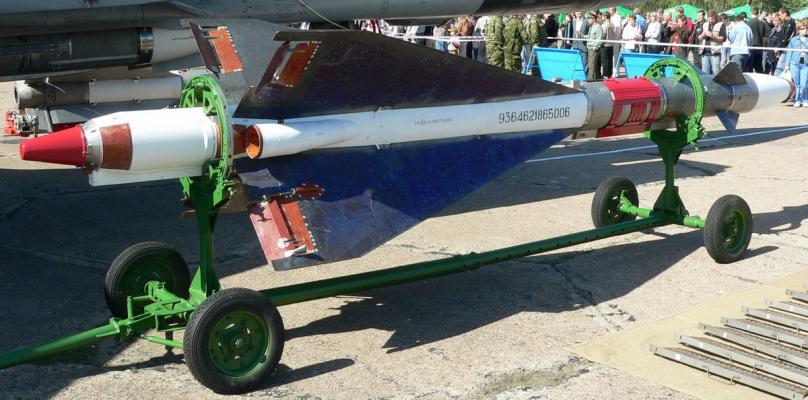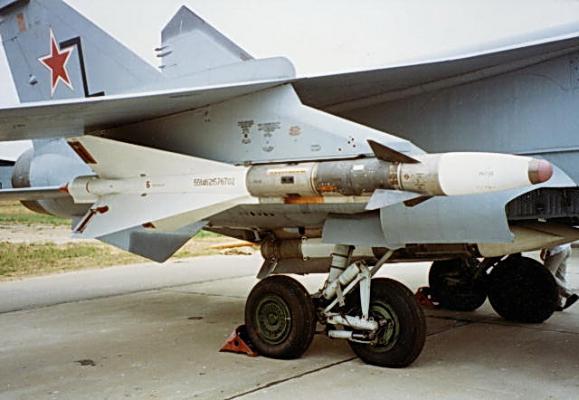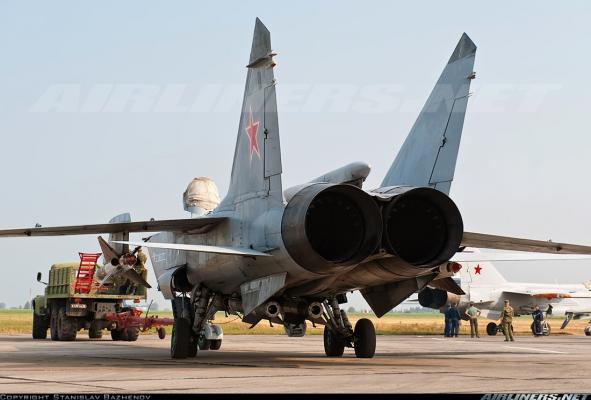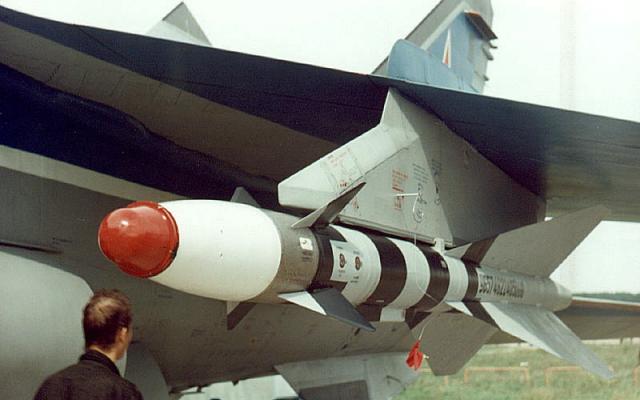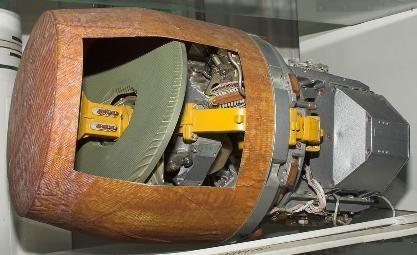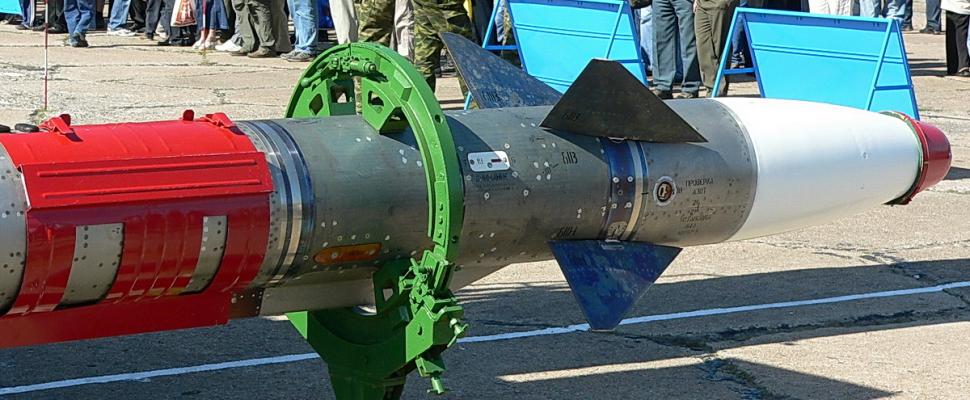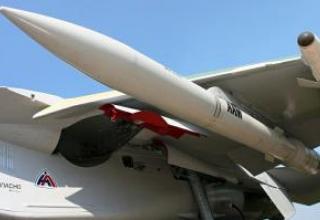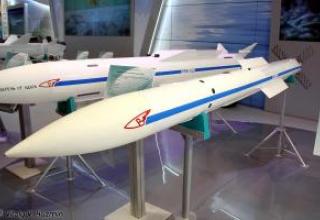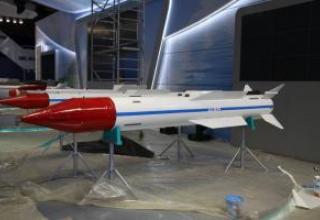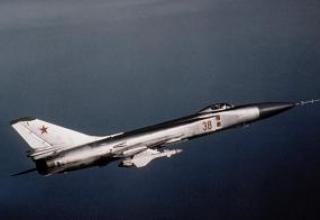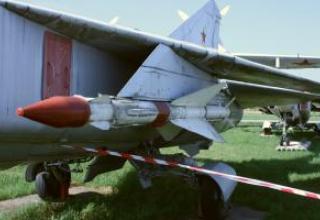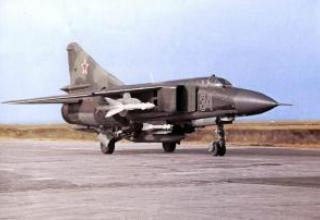Development of the K-40 missile began with the transition from the heavy fighter family E-150 with missiles K-9 and K-8 to two-engine aircraft - the future MiG-25. The conceptual design of the new aircraft in versions of the interceptor C-155 and the scout E-155R was released in 1961.
The creation of C-155 and E-155R was determined by the Decree of the USSR Council of Ministers dated February 5, 1962.., which set the deadline for the submission of these aircraft systems for joint state trials - the end of 1964. The development of missile weapons of the interceptor was entrusted to the OKB-4 headed by M.R. Bisnovatom, a semi-active radar homing head was created by NII-648, a thermal homing head by TsKB-589, an autopilot by OKB-3, a combined radio-optical fuse by NII-571, a solid fuel engine by KB-2 of Plant No. 81, an engine fuel charge by NII-6, and a combat unit by GSCB-47.
Double increase in weight of the carrier in comparison with planes of family E-150 provided possibility of application of rockets, on mass-sized characteristics close to worked out at that time K-80 for Tu-128-80.However conditions of application of rockets contained essentially new element: interceptor C-155 was intended for rather long, duration in tens minutes, flight with speed almost three times exceeding sound. In this case, the elements of the design of both the carrier and placed on the outer wing suspension of the missiles were heated to temperatures around 300 ° C. In addition to the problems associated with the strength of materials, it was necessary to solve the problems of maintaining the performance of the equipment, as well as preventing the heating of the rocket engine. It was necessary to provide satisfactory dynamic parameters of rocket armament in a wide range of speeds and flight heights.
As a result, the development was practically anew, without unification with K-80. Already in 1962 was released advance project on K-40 ("product 46"), which contained two versions of the missile layout. For further development, the "duck" scheme was adopted instead of the normal one used in K-80. To increase the probability of hitting the target missile was equipped with two types of homing heads: semi-active radar (PARGSN) and thermal. The latter was especially important, as the missile was designed to engage high-speed targets that had a high thermal contrast due to rapid heat.
The development progress was somewhat slowed down due to a number of forced transformations of the developers' cooperation. The autopilot for K-40 missile was assigned to Factory No. 118. Soon the creation of radar SLN transferred from NII-648 to the developer of the radar "Smerch-A" - NII-131 (hereinafter - NPO "Phasotron"). At the same institute a team of designers headed by E.N. was also created. Genishta and his deputy B.I. Kononuchenko continued to work on SSS for K-40. As a result of replacing the most important allied designers, the development was put back a couple of years. As a safety net, we considered the possibility of S-155 flight tests with weapons on the basis of K-80 missile, which was created for the Tu-128. Activated the flight testing of the locator "Smerch-A" and missiles K-80 on aircraft of the family E-150/E-152. However, the overall progress of work on other elements of the aircraft and missile complex also lagged behind previously set terms.
Tests onboard aircraft radar "Smerch-A" and missile weapons were carried out at the flying laboratory - a modified Tu-104 ¹ 42736, which already in 1965 performed 23 flights to practice GSN missiles.
The first flight of the future MiG-25 in the version of a scout took place on March 15, 1964, the interceptor - October 26 of the same year. Until the end of the year, the fighter performed three flights with two models of missiles to confirm the aerodynamic characteristics of the aircraft with suspended weapons. In this case, due to the unpreparedness of regular launchers mock-ups of missiles K-40 were placed on the ACU-8 from K-80.
The third prototype of the interceptor began testing with a full set of avionics only on April 16, 1967. In 1965 none of the channels of the combined radio optical fuse was brought to the operational condition.
However, it was not an obstacle for the beginning of development of ballistic and autonomous missiles. In 1966, there were two launches of K-40 from a ground-based launcher and five from the first two prototypes of the interceptor. Flight testing of the GSN began on the flying laboratory Tu-104 and the second prototype E-155P2.
Initially, it was planned to equip the aircraft with only two K-40. But carried out in 1968 flights of the third prototype of the C-155-3 interceptor with four missiles, which reached a speed of 2900 km / h, confirmed the possibility and usefulness of such an enhanced version of weapons. With this aircraft, as well as the fourth prototype interceptor and the Tu-104 performed launches of four autonomous and five telemetry missiles. At the same time, when testing the radar "Smerch-A" on the Tu-104 № 326 determined the range of detection and capture of a large target - 96 and 65 km, respectively.
In August 1968, began the second phase of state tests conducted at the GKI air force range. During the year, involving the fourth and mostly the fifth prototype interceptor conducted launches of three autonomous, nine thermal and 20 "radium" missiles in telemetry and combat equipment, which managed to shoot down six Yak-25RV, 12 MiG-17, three IL-28, one Tu-16 in unmanned versions and two parachute targets. The most impressive was the defeat of two PKM target missiles flying at an altitude of 25 km at a speed of 3000 km / h from the board of MiG-25, which launched missiles at an altitude of 20 km at its own speed of 2000 km / h. On the Tu-104LL, otherwise known as LL-104, was conducted additional testing of homing heads PARG-12BV, T-40A and T-40A1. In total, 245 E-155P flights and 92 Tu-104 flights were performed during the year.
Next year, along with the launch of eight autonomous and three vibrating missiles fired 23 telemetry and combat products at 12 targets: four MiG-17, four SLCs and jammers - two Tu-16 and one IL-28. This made it possible to complete state trials in February 1970 by shooting down eight more Tu-16s and three SLCs. During the year, two launches were made at a speed corresponding to M=2.4. In total, during the tests carried out 1291 flights, 105 rocket launches on 33 targets.
At the Tu-104LL studied the behavior of missiles in a complex interference situation. In addition to training launches in the development of MiG-25P combat pilots almost 30 launches were conducted in preparation for the planned display of new equipment to senior leaders of the party and government. During the general rehearsal, a couple of IL-28s were successfully "crashed". In 1971, in front of the biggest bosses four missiles shot down both IL-28. These launches, along with the firing of six K-40Ts at the PRM-1, were also regarded as serial tests. In addition, another 12 launches destroyed eight of the nine targets: MiG-17, KPM, M-6 and PM-1.
By the Decree of the USSR CM of April 13, 1972 the complex was adopted for service under the name of MiG-25-40, the radar received the designation of the RP-SA, and missiles - R-40. The missiles were mass-produced at the Kaliningrad Machine-Building Plant from 1965 to the late 1980s.
After the adoption of the airborne interceptor missile complex, work was continued to expand its combat capabilities. Already in 1972, MiG-25 ¹ 8408 shot down the MiG-15 at an altitude of only 500 m.
MiG-25 is undoubtedly a unique achievement of the world aircraft industry, the fastest high-volume aircraft in the world. It is indicative that both in the USSR and in the ocean, the development was carried out simultaneously on the versions of the fighter (MiG-25P and YF-12) and the reconnaissance aircraft (MiG-25P and SR-71). The Americans stopped the development of the interceptor: even without countermeasures only about two hundred of our bombers could have reached the USA technically. Using conventional weapons, the damage from such a raid would not exceed the cost of the shot down aircraft, and in nuclear war a couple of hundred bombs were lost against the background of thousands of ballistic missile warheads. On the contrary, the Soviet Union was threatened not only by triple the number of B-52s, but also by thousands of tactical and deck aircraft that could cause trouble even before the transition to nuclear apocalypse.
The approach close to three-axis speed required new technical solutions not only from aircraft designers, but also from radar and missile designers, who were working under the "heat barrier" for the first time for a long time. With the exception of this specificity, the MiG-25 radar mainly corresponded to the radar from the Tu-128, while the inability to find targets on the background of the ground was considered not so depressing given the purpose of the MiG-25 as a high-speed interceptor - hunter for B-70 and SR-71. However, the "Valkyrie" never went into series, and the number of built SR-71 in dozens of times inferior to the total issue of MiG-25.
During the serial production of MiG-25-40, as always, "small" modernization was carried out: the radar "Smerch-A1" was replaced by "Smerch-A2", followed by "Smerch-AZ". Shots were fired to confirm the performance of the innovations, during which relatively cheap La-17 targets were widely used. In 1974, tests were carried out for firing of La-17 thermal missiles flying against the ground.
At the same time, the "big" modernization of Mig-25 and its armament was also considered. To increase the range, speed and altitude of the upgraded MiG-25 was to be equipped with improved engines R-15BF2-300, install a new radar with a target detection range of 120 km and arm it with K-40M missiles ("product 65"), capable of hitting targets at a distance of 60 km - twice as much as the K-40. Developments on the K-40M, which began in 1973, provided for the introduction of a scheme with the capture of the target GSN not on the suspension under the carrier, and on the flight path, as it was already implemented on the K-24.
These works were carried out without much haste and were not of priority nature: in parallel, the development of a much more promising C-155M, the future MiG-31 was underway. Nevertheless, in May 1976, a sketch design for the missile K-40M was released, the corresponding decree remained only to approve the CPSU Central Committee, but absolutely unforeseen circumstances have sharply accelerated and completely changed the main focus of work on a new modification of the weapons of the MiG-25P.
On September 6, 1976, Viktor Belenko, who took off from the Chuguevka airfield in the Far East, landed his MiG-25P at the Japanese airport Hakodate. The consequences of this incident were obvious: the aircraft's radio electronic equipment and weapons became available for study by the probable enemy. This provided the United States and its allies with excellent prospects for developing effective countermeasures. Within just two months, it was possible to develop an urgent but well-thought-out response.
The party and government leadership, by a decree of November 4, 1976, set a detailed program for the implementation of appropriate countermeasures, which included, in particular, the replacement of the radar and weapons of MiG-25P. Extremely strict implementation terms were set: the new equipment had to be submitted for state testing in exactly one year, in November 1977. Taking into account the acute shortage of time, the new radar was based on the last serial novelty of the domestic equipment - a locator of the Sapphire-23 family (RP-23) created for the MiG-23M. The most important advantage of this station, which consists in the ability to detect and track air targets on the ground background, was achieved by using a mode of quasi-continuous radiation. Due to this feature, the new station was incompatible with the PARGSN of R-40 missiles.
The task of finalizing the weapons was solved in the simplest way: the K-40D missiles installed new GSS RGS-25, based on RGS-24 missiles designed for MiG-23ML and MiG-23P. R-24 missile had a much smaller diameter, which led to a length reduction of 0.165 m, which is characteristic of the buckling of the front of the improved missiles R-40R, named R-40RD. SSS RGS-25 was developed at NIIP by the team headed by the Chief Designer E.N. Genishta and its deputies M.N. Gushchin and B.S. Patrykeev. The variant with increased according to the sizes of K-40 antenna of GSN was also considered. However, having an advantage in the range of target tracking, such a CNS due to narrowing the beam did not provide its capture with a given probability.
A thermal modification of the missile, designated P-40TD and equipped with an advanced homing head, which provides an attack in both the front and rear hemispheres of the target, was also modified. The nitrogen cooling system of the CNS photoreceiver was placed on the missile.
Even before the resolution was adopted in autumn 1976, the preparation of technical documentation for the K-40D missile began. There was no time to issue technical proposals and sketch design, and the high degree of borrowing elements from the standard K-40 and K-24 minimized the technical risk. Three modernized aircraft were prepared: MiG-25PD ("interceptor modified") №3305, which made its first flight on November 19, 1977, as well as aircraft №3306 and 3307. The following year, they performed more than 200 flights. They were joined by two previously manufactured MiG-25P (Nos. 84027017 and 84031402), modified and designated MiG-25PDS ("Interceptor modified in service"). At the initial stage of flight tests, autonomous and program launches were conducted from the flying laboratory LL-84D (upgraded MiG-25 No 1104).
The first three launches of missiles with working CNS were unsuccessful. It turned out that the airplane radar transmitter did not switch from the equivalent to the antenna, with this effect was manifested only in flight conditions, and not in ground checks. In the end, the cause of the failure was found and the tests were successful.
The complex completed the tests in 1979 and was adopted by a decree of 16 June 1980 under the name MiG-25-40D. At the same time, the radar received the designation of RP-25, and the missile - R-40D. Tests of new missiles were conducted in 1982-1983.
R-40D missiles were the implementation of only the first stage of modernization of K-40 type missiles. The development of technology since the early 1960s allowed for the application of other innovations in addition to the new GSN. The decision of the military-industrial complex of August 17, 1981 set the development of K-40D-1 missiles, equipped, in particular, with a new more powerful shrapnel and rod combat unit and fuse "Bekas". The following year, the missiles were prepared for testing. In 1983, completed the factory, and the following year - the state tests conducted on MiG-25PD ¹ 1004, during which was launched 21 missiles K-40D-1 and 16 previously adopted in service R-40D. According to the results of the tests, the missile went into mass production, was sent to the troops, but it was also required a number of improvements to implement the observations of the State Commission and ensure the use of the missile on the MiG-31. The corresponding work lasted about five years. For example, in 1988 the tests continued on the MiG-31 № 1604.
It should be noted that in terms of target detection range the MiG-25PD airborne radar was one and a half times better than even the MiG-23ML, not to mention earlier modifications of the "twenty-third". R-40D missiles also were not inferior to R-24 in terms of power, surpassing them in combat unit power. Therefore, of all the Soviet aircraft delivered to the Islamic world, only the MiG-25PD met the objectives of long range missile battle with aircraft of the fourth generation of American production. On the other hand, conceived as a high-altitude air defense interceptor, it was almost unsuitable for maneuverable close air combat, quite likely in the event of failure of an attack at medium ranges.
The P-40 family of missiles designed for MiG-25P interceptors is likely to survive its carriers, which have already been mostly decommissioned by Russian and other CIS countries. R-40 is used in the armament of more modern MiG-31 aircraft, as designed specifically for this aircraft, R-33 missiles have only radar CNS. Therefore, these interceptors in the standard version carry on the wing pylons of R-40T missiles, and on the under the fuselage - R-33. In addition, R-40 family missiles are also in service with MiG-25P missiles delivered abroad, which are likely to remain in service for a long time.
In the west, R-40 missile was designated AA-6 Acrid.
Composition:
The P-40 missile is designed according to the "duck" pattern (see projections). To ensure the altitude of the combat application and reduce the effect of synchronous errors, a large wing has been used. Aerodynamic heating at high supersonic intercept speeds forced designers to abandon the use of conventional construction materials - the body of P-40 is made of steel and titanium, the wing is made of titanium. The missile casing is protected with a layer of external thermal insulation.
P-40 missile consists of five compartments connected by flange connections. The nose section contains a semi-active radar or homing head. Behind it there is a hardware compartment, where the steering unit of aerodynamic rudders, autopilot equipment, blocks of optical and radar channels of combined fuse are located. On the case there are antennas of the receiver, and behind them - transmitting radio channels of the fuse. Solid fuel rocket engine PRD-134 is located in the middle part of the rocket. Behind the engine there are steering aileron drive machines and power supply unit with gas generator and turbogenerator. In the tail of the missile is a shrapnel-flag warhead.
The central location of the engine ensures that the balance is maintained as fuel is produced during long flight. The PRD-134 engine is a two-nozzle engine with nozzles placed on the sides of the hull. The PD-134 engine weighs 118 kg and is made of high-energy mixed metal-containing fuel. For protection against heating, the titanium engine case has an external heat protection coating in addition to the internal one.
To maintain the thermal operation of the equipment, a cooling system is installed in the equipment compartment, which is fed with liquid freon from a cylinder placed in an aircraft starting device. The internal surfaces of the compartment have additional heat protection coating. The power to the steering drives and electric generators of the equipment is provided by three powerful PADs. Receiving antennas of radio command communication line and tracers are installed in the tail section for flight control and monitoring.
The powerful engine and developed wing ensure that the P-40 missile can defeat targets flying with high excess. The rocket provides defeat of the targets flying at a speed of up to 3000 km / h at altitudes from 0.5 to 27 km, including practicing maneuver with an overload to 2.5 units. When shooting in the rear hemisphere, the range of launch ranges was from 2.3 to 15 km, in the front hemisphere the launch range reached 30 km.
For P-40D the range of altitudes of the targets was from 0.05 to 30 km, the range of launch ranges was from 1.0 to 20 km in the rear hemisphere, at maximum range when shooting in the front hemisphere - 40 km. It was provided defeat of the targets maneuvering with an overload to 4 units. The weight of the rocket was reduced to 465 kg, length - to 5.95 m.
BC of rocket P-40 - shrapnel-phase weight of 38 kg with the narrowly directed field of defeat. The BC is detonated by a combined radio optical fuse "Stork-M", which ensures the accuracy of the command and high interference immunity. Radius of effective defeat is 7 m.
The R-40RD-1 (R-40TD-1) missile is equipped with a high-efficiency shrapnel and blast warhead with a total mass of 55 kg. The BC is equipped with an advanced Bekas radio-optical fuse. The radius of destruction is 13 m. The unit is equipped with the improved radio-optical fuse Bekas. The length of the missile is 6.1 m.
For the first time in domestic and world practice, the PARG-12 semi-active pulse radar homing head of the P-40R missile used a monopulse method of information processing and a rangefinder with two integrators, which provides greater resistance of the GSN to the effects of amplitude interference in comparison with previously created heads with conical scanning. Original circuits of a stabilized microwave generator and a reference signal receiver were also implemented in the CNS. In contrast to the previously applied circuitry with automatic gain control, implemented in this SOS logarithmic characteristics of the receiver excluded "dazzle" at sharp power drops interference. The unevenness of logarithmic receivers caused the appearance of oscillations at the output of the goniometer in the so-called intermittent interference. This effect was significantly attenuated by switching the receivers according to a random law.
PARG-12 head has developed logic and high protection against interference. To form a four-blade pattern of direction necessary to organize monopulse processing, as well as to provide maximum (± 70 °) deviations of the same direction in the RGS PARG-12 used two-mirror antenna Kassegren. Moving mirror of the antenna is irradiated by the flow, stationary relative to the missile. In this case, the equal-signal direction of the directional diagram is rotated by twice the angle of the mirror turn. A calculator was created on the basis of a sinus-cosine rotating transformer, which converts the given overloads into a related coordinate system taking into account the acceleration and braking of the missile. This made it possible to construct guidance by the method of proportional navigation in the antenna coordinate system, when the projection of the full overload of the missile on a plane perpendicular to the range line is proportional to the product of evaluation of the angular velocity of the range line on the velocity of approach. Record bearing of the accompanied target and pointing in the antenna system made it possible to intercept a high-speed target at large angles.
In developing the P-40 missile control system, the so-called variable structure system was used to limit the overload, comparing the sum of the current overload and its derivatives with a given threshold and zeroing the command when the threshold is exceeded. In connection with the development of P-40P, the issue of synchronous errors of the fairing and antenna system has become much more acute. The Kassegren antenna proved to be very unstable in terms of bearing error, whose bearing gradient limits the altitude of the missile. To control the synchronous errors of the heads in production was developed a measurement system based on the use of a rolling stand, on which the head is installed, and a correlation algorithm to determine its response to base vibrations. The introduction of this system has contributed to improving the antenna systems and fairings of medium-range missiles. The PARG-12 SSS could perform all-round target acquisition from a distance of up to 30 km.
The upgraded R-40RD was equipped with a continuous radar homing head RGS-24 borrowed from R-24 missile. At the beginning of the R-40RD missile's flight a program homing section was implemented, the duration of which reached 30% of the flight time, and then the homing was carried out.
R-40T was equipped with thermal GSN T-40A1. The T-40A1 shroud is made of heat-resistant Kemnium and optoceramic-based satallic. The homing head took target designation within ±55° and captured the target before the launch of the missile. The T-40A1 uses signal processing principles that provide a high degree of protection against false thermal interferences. R-40TD and R-40TD-1 missiles are equipped with 35T1 SNS.
R-40 missiles were hanged on ABU-84-46 launchers.
Modifications:
| P-40P (K-40, "product 46") | from the PARG-12 radar GSN. |
| P-40RD (K-40D, "product 46D") | with radar GOS RGS-25. It was developed in 1976-1979. |
| P-40RD-1 (K-40D-1, "product 46D-1") | is equipped with a Bekas radio optic fuse and a more powerful BC. It was developed in 1983. |
| P-40T (K-40, "product 46") | with thermal GSN type T-40A1. |
| P-40TD (K-40D, "product 46D") |
with a 35T1 Heat SNS (see photo1, photo2). It was developed in 1976-1979. |
| P-40TD-1 (K-40D-1, "product 46D-1") | is equipped with a Bekas radio optic fuse and a more powerful BC. It was developed in 1983. |
Characteristics:
| R-40R | R-40RD | R-40Т | R-40ТD | |
| Maximum firing range, km | 30 | 60 | 36 | 60 |
| Launch height, m | 50-30000 | |||
| Maximum operating overload | 8g | |||
| Dimensions, mm: - length - fuselage diameter - wingspan - steering wheel range |
6379 300 1450 714 |
5980 300 1450 714 |
||
| Starter weight, kg | 469 | 471 | ||
| Weight of combat unit, kg | 38 | 55 | 38 | 55 |
Testing:
Having unique flight and tactical characteristics, MiG-25P for a long time was operated only as part of the Soviet air defense fighter aircraft. In the early 1980s, its delivery abroad began, and soon its baptism of fire took place. Even before the beginning of the large-scale Lebanese conflict, in spring 1981, the Syrians announced the destruction of the F-15.
According to the Iraqi Air Force Command, from December 1982 to October 1986, during the Iran-Iraq war, the Iraqi MiG-25 shot down an Iranian F-5E fighter, an EU-130E counter-electronic aircraft, and three Phantoms, including one in a reconnaissance version.
During Operation Desert Storm, January 17, 1991, Iraqi MiG-25 managed to shoot down an American F/A-18, and in 2002 - an unmanned reconnaissance drone Predeitor.
Sources:
- Р.Ангельский. "Отечественные управляемые ракеты "воздух-воздух". Авиация и Космонавтика.
- В.Марковский, К.Перов. "Советские авиационные ракеты "воздух-воздух"- М.:, Экспринт, 2005,-48с.
- А.Никифоров. "Под крылом самолета". Аэроплан.
- Боечкин И. "С индексом "Р". "Техника - молодёжи" - 2000. - №9. - С. 30-35.
- Военная авиация. - Кн. 2. - Мн.: "Попурри", 1999. - С. 263-264.
- Дмитриев Г., Серёгин С., Попсуевич С. "МиГ-25 и модификации" - Киев: "Архив-Пресс", 1995.
- Ларионов А. "Гастроном" или "не под открытым небом спим". Мир авиации. - 1998. - №3. - с. 12-47.
- Левин М.А. "Пустил и забыл". Крылья Родины. - 1993. - №1. - С. 32-33.
- Сайт "Современная авиация России"
- AA-6 `ACRID' (R-40, R-46)
- Р-40 (AA-6 ACRID)
- Евгений Ерохин. Музей Войск противовоздушной обороны РФ, п. Заря, М.О.
